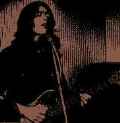 Acoustic Roots
Acoustic Roots| PART ONE | from Signals Fanzine #2 Christmas 1997 |
 Acoustic Roots
Acoustic Roots| PART TWO |
from Signals Fanzine #3 Summer 1998 |
 blues with an imitation of the piano based on
an alternating bass guitar pattern. The music does not always follow
the standard '12 bar' format and often incorporated strong melodic
tunes, complicated fingering and typically clever and amusing blues
lyrics. The men who played the music came from many different parts of
the Southern States and were perhaps the most popular 'race' artists of
their time.
blues with an imitation of the piano based on
an alternating bass guitar pattern. The music does not always follow
the standard '12 bar' format and often incorporated strong melodic
tunes, complicated fingering and typically clever and amusing blues
lyrics. The men who played the music came from many different parts of
the Southern States and were perhaps the most popular 'race' artists of
their time. | PART THREE |
from Signals Fanzine #4 Autumn 1998 |
 The picking technique and pattern used is worth
working at and involves the flatpick striking an alternating bass pattern with
the middle and index fingers playing the three treble strings in the
order 3rd string, 1st and 2nd every beat. This pattern is repeated
throughout the song over the chord shapes of C and D7, although the
song can also be simply strummed. The chord of G7 is phrased with a
flatpicked run which follows the melody of the song before resolving
back to C.
The picking technique and pattern used is worth
working at and involves the flatpick striking an alternating bass pattern with
the middle and index fingers playing the three treble strings in the
order 3rd string, 1st and 2nd every beat. This pattern is repeated
throughout the song over the chord shapes of C and D7, although the
song can also be simply strummed. The chord of G7 is phrased with a
flatpicked run which follows the melody of the song before resolving
back to C.|
Mailing & Discussion List  |
|
|
|
|
|
|
| Forward to next article |